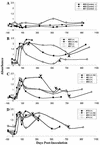An aspartyl protease inhibitor orthologue expressed by Parelaphostrongylus tenuis is immunogenic in an atypical host
- PMID: 12093670
- PMCID: PMC120043
- DOI: 10.1128/cdli.9.4.763-770.2002
An aspartyl protease inhibitor orthologue expressed by Parelaphostrongylus tenuis is immunogenic in an atypical host
Abstract
Parelaphostrongylus tenuis is a neurotropic nematode common in white-tailed deer (Odocoileus virginianus) of eastern North America. This parasite is the causative agent of a debilitating neurologic disease in atypical hosts, including domestic livestock. In order to identify proteins of potential significance in the host-parasite relationship, a cDNA library was produced from adult P. tenuis mRNA. Screening the library with antisera from infected red deer (Cervus elaphus elaphus) and immunized AO strain rats, we identified clones with sequence similarities to aspartyl protease inhibitors from several parasitic nematodes. Antibody that was generated against this recombinant protein of P. tenuis (Pt-API-1) detected the native protein in E/S products, in muscle and gonad, and on the surface of the cuticle of adult male and female P. tenuis. The native protein was detected in internal structures of first-stage (L1) and third-stage (L3) larvae. Reverse transcription-PCR confirmed expression of Pt-api-1 in L1, L3, and adult male and female worms. Expression of Pt-API-1 throughout the life cycle of P. tenuis suggests an essential function. Antibodies specific for recombinant Pt-API-1 were detected by enzyme-linked immunosorbent assay in sera from 12 red deer experimentally infected with P. tenuis. Antibodies were detected within 28 to 56 days postinfection. Responses were sustained or biphasic in animals with patent infections, consistent with expression of Pt-API-1 by L1. Our results are compatible with findings in other parasitic nematodes showing that aspartyl protease inhibitors are highly immunogenic.
Figures




Similar articles
-
Construction of a complementary DNA library for Parelaphostrongylus tenuis and identification of a potentially sero-diagnostic recombinant antigen.J Parasitol. 2008 Dec;94(6):1402-9. doi: 10.1645/GE-1557.1. J Parasitol. 2008. PMID: 18576849
-
Identification of antigens with potential for immunodiagnosis of Parelaphostrongylus tenuis and Elaphostrongylus cervi infections in red deer (Cervus elaphus elaphus).J Parasitol. 2002 Jun;88(3):587-93. doi: 10.1645/0022-3395(2002)088[0587:IOAWPF]2.0.CO;2. J Parasitol. 2002. PMID: 12099432
-
Establishment of adult Parelaphostrongylus tenuis, patent infections, and acquired immunity after experimental infection of white-tailed deer (Odocoileus virginianus) and red deer (Cervus elaphus elaphus).J Parasitol. 2004 Apr;90(2):245-54. doi: 10.1645/GE-2873. J Parasitol. 2004. PMID: 15165045
-
Cloning and characterisation of an aspartyl protease inhibitor (API-1) from Ancylostoma hookworms.Int J Parasitol. 2005 Mar;35(3):303-13. doi: 10.1016/j.ijpara.2004.11.014. Epub 2005 Jan 8. Int J Parasitol. 2005. PMID: 15722082
-
Co-evolutionary relationships between the nematode subfamily Cloacininae and its macropodid marsupial hosts.Int J Parasitol. 2001 Jul;31(9):976-96. doi: 10.1016/s0020-7519(01)00200-4. Int J Parasitol. 2001. PMID: 11406145 Review.
Cited by
-
Characterization of a novel aspartyl protease inhibitor from Haemonchus contortus.Parasit Vectors. 2017 Apr 19;10(1):191. doi: 10.1186/s13071-017-2137-1. Parasit Vectors. 2017. PMID: 28420411 Free PMC article.
-
Epidemiological Investigation of Meningeal Worm-Induced Mortalities in Small Ruminants and Camelids Over a 19 Year Period.Front Vet Sci. 2022 Apr 6;9:859028. doi: 10.3389/fvets.2022.859028. eCollection 2022. Front Vet Sci. 2022. PMID: 35464381 Free PMC article.
-
Analysis of heavy-chain antibody responses and resistance to Parelaphostrongylus tenuis in experimentally infected alpacas.Clin Vaccine Immunol. 2012 Jul;19(7):1019-26. doi: 10.1128/CVI.00178-12. Epub 2012 May 16. Clin Vaccine Immunol. 2012. PMID: 22593238 Free PMC article.
-
Cathepsin B homologue at the interface between a parasitic nematode and its intermediate host.Infect Immun. 2006 Feb;74(2):1297-304. doi: 10.1128/IAI.74.2.1297-1304.2006. Infect Immun. 2006. PMID: 16428779 Free PMC article.
-
Application of monoclonal antibodies in functional and comparative investigations of heavy-chain immunoglobulins in new world camelids.Clin Diagn Lab Immunol. 2005 Mar;12(3):380-6. doi: 10.1128/CDLI.12.3.380-386.2005. Clin Diagn Lab Immunol. 2005. PMID: 15753251 Free PMC article.
References
-
- Anderson, R. C. 1963. The incidence, development, and experimental transmission of Pneumostrongylus tenuis Dougherty (Metastrongyloidea: Protostrongylidae) of the meninges of the white-tailed deer (Odocoileus virginianus borealis) in Ontario. Can. J. Zool. 41:775-792.
-
- Anderson, R. C. 1965. The development of Pneumostrongylus tenuis in the central nervous system of white-tailed deer. Pathol. Vet. 2:360-379. - PubMed
-
- Anderson, R. C. 1992. Nematode parasites of vertebrates: their development and transmission, p. 151-208. CAB International, Oxon, United Kingdom.
-
- Anderson, R. C., and A. K. Prestwood. 1981. Lungworms, p. 266-317. In W. R. Davidson, F. A. Hayes, V. F. Nettles, and F. E. Kellogg (ed.), Diseases and parasites of the white-tailed deer. Tall Timbers Research Station, Tallahassee, Fla.
-
- Anderson, R. C., and U. R. Strelive. 1966. Experimental cerebrospinal nematodiasis (Pneumostrongylus tenuis) in sheep. Can. J. Zool. 44:889-894. - PubMed
Publication types
MeSH terms
Substances
Associated data
- Actions
LinkOut - more resources
Full Text Sources
Other Literature Sources

